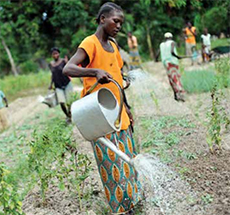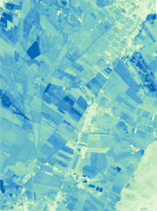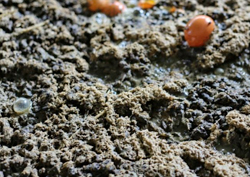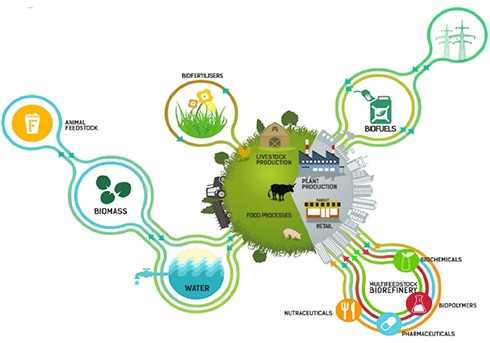Circular Economy: Waste-to-Resource
Waste to Resource: Circular Economy can increase resilience

The COVID-19 pandemic have moved many countries into a long period of lockdown. The restrictions on transport and economic activities are constraining the supply-side capacity, resulting in significant increases in food loss and waste, especially of perishable agricultural produce. Producers are also being impacted by the diminished access to important inputs to agriculture such as inorganic fertilizers. Due to labor shortage and exposure risk, human and animal waste management which are crucial to protect public health and the environment, have also become a challenge under the current restrictions imposed by the COVID-19 crisis.
Although viral fragments of COVID-19 have been found in excreta, there is no evidence to date that the COVID-19 virus has been transmitted via sewerage systems with or without wastewater treatment. However, as a precautionary approach and because of other potential infectious disease risks from excreta, wastewater should be treated in well-designed and well-managed centralized wastewater treatment works. A waste stabilization pond (an oxidation pond or lagoon) is generally considered to be a practical and simple wastewater treatment technology that is particularly well suited to destroying pathogens, as relatively long retention times (20 days or longer) combined with sunlight, elevated pH levels and biological activity serve to accelerate pathogen destruction. A final disinfection step may be considered if existing wastewater treatment plants are not optimized to remove viruses.
Lockdown measures are driving a major shift towards a “circular economy” approach. A circular economy aims to maintain the value of products, materials and resources for as long as possible by returning them into the product cycle at the end of their use, while minimizing the generation of waste. It can contribute to several different Sustainable Development Goals (SDGs), including SDG 2 End hunger (via sustainable food production), SDG 6 Clean water, SDG 7 Affordable and clean energy, SDG 12 Responsible consumption and production, SDG 13 Climate action, and SDG 15 Sustainable use of terrestrial ecosystems. In prioritizing resource efficiency and resilience, the circular economy and the climate mitigation agenda are inextricably linked and mutually reinforcing.
A ‘circular agriculture economy’ proposes a viable model for the current linear economy “take-make-waste” approach by minimizing the amount of external inputs for agricultural production, closing nutrient loops and reducing negative impacts to the environment by eliminating discharges (i.e. wastewater) and surface runoff. Under the lens of the circular economy, agriculture can offer a multitude of opportunities from primary production using precision agriculture techniques, to the recycling and utilization of agricultural wastes and materials (i.e. reuse of plastic containers).
The opportunities

- Water reuse: cities, towns and agriculture generate a stream of water that has already been used, such as for domestic and agricultural production purposes. This stream of water represents a waste product which must be either disposed of safely or re-used as a resource. Apart from its value as water, it may also contain nutrients which benefit agricultural production. Although agricultural production close to cities is the most cost effective use of recycled urban water, several other agricultural activities can also benefit from local recycling schemes. For example, animal production operations generate a substantial amount of wastewater which is rich in organic matter containing macro and micro nutrients important to agriculture. After being properly managed/treated, agricultural wastewater can be safely used in pastures and/or plant production.
- Recycling of irrigation water: drainage flows from irrigated areas can be important assets in water management. Losses in one place become inputs for other areas. The presence of such recycling can substantially ease the upstream management problem by allowing less precision in distribution, knowing that any surplus will not be lost. Return-flow systems where drainage and surplus irrigation are channeled back to the irrigation network itself represent an opportunity for managers to store positive perturbations, for example to harvest rainfall.

- Precision agriculture: it is based on the optimized management of inputs in a field according to actual crop needs. It involves gathering, processing and analyzing temporal, spatial (including satellite positioning systems like GPS and remote sensing) and individual data combining them with other information to support management decisions to manage crops and the use of fertilizers, pesticides and water at ‘the right amount, at the right time, in the right place’. By doing so, optimum performance is achieved with less quantities of inputs and resources needed leading to minimal environmental impact.
- Biofertilizer: organic wastes including food waste, crop stalks and stubble (stems), leaves, seed pods and animal waste are usually produced throughout farming activities. These wastes are the cheapest resource that can be used by farmers, when it is managed safely and converted into biofertilizer products. The use of biofertilizer can add nutrients to promote plant growth, maintain soil fertility and sustainability, ensuring the production of safe and healthy food, providing an economically viable support to farmers for realizing the ultimate goal of increasing productivity and sustainability. It is also a cost-effective and renewable source that can potentially supplement or even substitute inorganic fertilizers.

- Bioenergy: is energy produced from biofuels. It comprises electricity, heat and a wide range of transportation fuel. Biofuels is energy produced directly or indirectly from biomass. Biofuels can include for example, liquid biofuels i.e. fuel derived from biomass for transportation uses, gaseous biofuels such as methane gas, and solid biofuels like fuelwood, charcoal etc. Sources of biomass include energy crops, agricultural and forestry wastes and by-products, manure or microbial biomass. Some examples are leaves, residues, cutover residues, sawdust, bark, chip, and corn husks among others. Bioenergy developments offer the opportunity for enhanced energy security and access by reducing the dependence on fossil fuels and providing a localized solution. Increased energy security in turn can have positive effects on food security.
For more info please contact:


